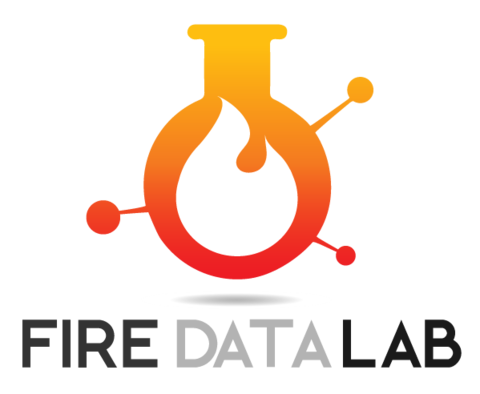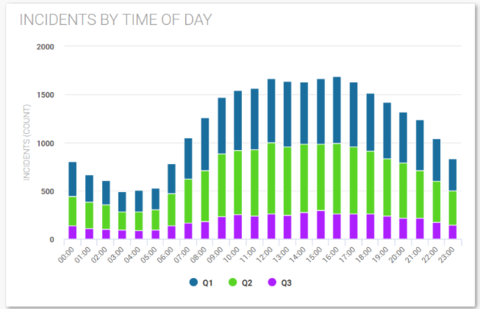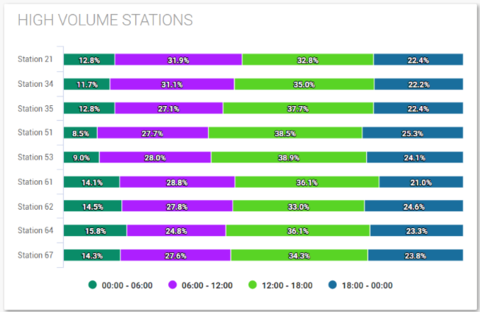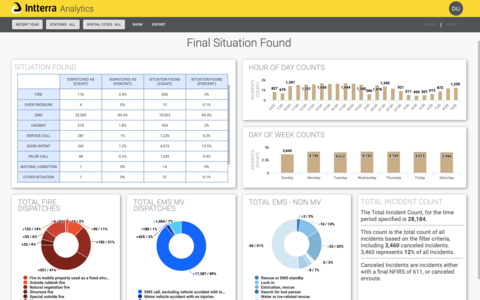Fire Data Lab: bringing fire service data analytics into the twenty-first century
PSCR Success Stories

As the volume of available data swells and analysis methods grow ever more sophisticated, a growing number of public safety agencies are turning to data analytics to drive strategic decision-making processes. Paradoxically, the vast majority of fire departments in the U.S. cannot access the data and analytics technologies required to address tremendous challenges affecting their work every day.

explained David Van Ballegooijen, the Project Coordinator of the Fire Data Lab project.
Fire fighters who are trained and equipped to handle exigent physical threats to public safety are now on the front lines of homelessness, drug addiction, and mental illness, providing social service functions to vulnerable community members. The typical 911 emergency care system and referral processes are myopic in nature and cannot meet the long-term needs of systemic public health crises; consequently, these community members are frequently the subjects of repeat 911 calls.
At the crux of this challenge is the lack of data needed to measure the outcomes of emergency response approaches and inform integrated response frameworks that are broader than police, EMS, and fire alone. This is the story of how the Western Fire Chiefs Association (WFCA) and the NIST Public Safety Communications Research division (PSCR) embarked on the mission to bring the data analytics capabilities of the fire service into the twenty-first century.

Envisioning a data-driven fire service
In 2016, WFCA identified a need among their members for modern data analytics capabilities. Data-driven decision-making had become the norm in other sectors, especially in Silicon Valley, and stakeholders had come to expect more than anecdotal information when it comes to how their fire departments were performing.
Drawing inspiration from FirstNet and PSCR’s Public Safety Analytics R&D Roadmap, WFCA envisioned a systematic framework in the United States where public safety organizations could perform advanced analysis of their own data and also compare regional performance data to generate useful insights. A core community of fire departments engaged in data analytics would provide guidance to newer departments and all could learn from the trends exposed by an ever-increasing master dataset.
Getting such an ambitious blueprint off the ground required a great deal of consensus building and momentum among WFCA’s members. The concept of integrating data analytics into their decision-making routines was in step with the day-to-day rhythm of life in the fire service.
“Teams of firefighters often operate like a family unit,” explained WFCA Project Manager David Van Ballegooijen. “They live together, they spend a lot of time together, they eat together, and issues in the fire service are often hashed out over food and so forth. So, having data analytics to refer to supplements their discussions and works with their natural flow and processes. And it has a positive effect overall.”
WFCA partnered with data analytics firm Intterra to build a framework that creates live connections to the data systems of fire departments – specifically CAD, AVL, and RMS. But, they had no idea how they would finance the technology deployment in the fire service.
An award under the 2017 Public Safety Innovation Accelerator Program enabled WFCA to move their project into high gear. The PSIAP award created opportunities for fire departments to receive training, ongoing guidance, and technologies required to engage in data analytics, and facilitated collaboration across departments
In the days following WFCA’s announcement of the opportunity, a deluge of inquiries poured in from over 150 fire departments eager to participate in the program. “That early progress let us know we were directly addressing an area of need in the fire service,” said David.
Tapping into the insights of performance data
Traditional methods used by fire departments to manage operations, track assets, and maintain incident records are inherently one-way systems, inhibiting the ability to share and analyze information between them. Each data silo holds a piece of the complete picture of the department’s activity but cannot exchange data with the other systems. The inability to see the convergence of performance data prevents public safety organizations from ascertaining trends not only in their districts but also on the regional and national levels. Furthermore, the absence of a centralized and normalized set of data with workflows hinders research and development of public safety tools and techniques, as well as future advances that will be made possible by FirstNet.
To overcome this problem, WFCA provided 29 fire departments serving over 20 million people with Intterra’s software platform and its associated data integration framework. These tools immediately provided each department with the capacity to conduct cross-domain performance analysis in a common framework. The framework acts as a unifying system-of-systems that does not replace any one fire service information technology tool, but allows the data within each to be made available for data-driven decision making.
Below: The Fire Data Lab aggregates data approximately 2.23 million calls per years and provide analytics and benchmarks to support data-driven decision making in the fire service.



Next, the fire department’s newly available data set is anonymized and shared with the federated, cloud-based Fire Data Lab warehouse. Authorized users have the ability to interact with the live dynamic data pool of millions of calls from across the western United States with tools for comparative analytical capabilities, community metrics, regional trending, and predictive incident forecasting based on time and location.

The initial stages of WFCA’s project brought unexpected challenges. Progress stalled in negotiations between the fire departments and their data systems vendors, who often attempted to charge large fees – up to $30,000 – just to allow fire departments access their own data. Even more, striking a balance between the departments’ various policies regarding data sharing was no small feat.
“Despite these challenges, the final lesson is that the system works,” said David Van Ballegooijen, the Project Coordinator. “We created a framework that is being used by and benefitting public safety right now, and that has a model to sustain itself into the future after the PSIAP grant funding is over.”
The service of last and first resort
The technical piece is only half of the Fire Data Lab story. Through a series of workshops and summits held across the western United States, WFCA built an energetic network of fire departments that are engaged in data-driven decision making. A key tenet of this community is their commitment to mentoring other departments seeking to gain access to and insights from performance data. The primary goal of the workshops was to define the types of resources departments need, the most urgent challenges they faced, and which metrics they could immediately put to use.
The most ubiquitous and taxing challenge for fire departments is heavy resource usage toward non-emergent calls related to substance abuse, homelessness, and mental health issues. Emergency response resources are stretched particularly thin in urban areas such as San Diego, where less than one percent of the population generates over 20 percent of 911 calls. Firefighters are often the first to respond to the calls involving individuals affected by homelessness, mental illness, and drug addiction.
Meanwhile, the person in distress is often shuffled through a disparate patchwork of emergency response, healthcare, and criminal justice systems that cannot execute the coordination and information sharing required to ensure deliberate, impactful care. When all is said and done, patients suffering from mental health and addiction issues rarely land on the road to recovery and wellness but are more often situated to repeat the cycles that caused the 911 call in the first place.
WFCA’s summits and workshop discussions revealed that a growing number of fire departments have established alternative community partnerships with other agencies and nonprofits to provide non-emergency medical care, immediate referrals, and transportation to resources and care providers. For example, specialized mobile crisis response teams are integrated into the local public safety systems of the cities and dispatched to a broad range of non-criminal crises, including homelessness, public intoxication, substance abuse and mental illness problems, and dispute resolution.

To justify the costs of these programs, fire departments are using data analytics to illustrate the value of community partnership interventions on public health and safety. “Outcome data” generated by public safety
agencies, medical providers, and social services demonstrate what happens to a patient conclusively after their care is turned over to other agencies and care providers.
Access to outcome data enables departments to identify deficiencies or unmet needs for services in their communities, highlight the positive impacts of alternative interventions provided by community partnerships, and ultimately improves their provision of care to vulnerable populations.

Read more about community partnerships in WFCA’s Community Solutions Summit Report.
Impacts of the Fire Data Lab Project
While outcome data can be difficult for departments to obtain due to information sharing regulations, David intends for the Fire Data Lab project to play a greater role in facilitating access to outcome data to fire departments. Now that the departments have the ability to collect and share information about what is happening in their districts, WFCA can begin to address policy barriers to information exchange through its advocacy efforts.
When the fire service communicates its needs to elected officials and the community, access to the data analytics tools provided by the program will continue to promote evidence-based reasoning as opposed to anecdotally based decision making. The ability to measure and define outcomes is enabling fire departments to shift the cost burdens of emergency response to more appropriate areas. The project is likely to encourage a more proactive approach to tackling complex challenges and creating efficiencies within the fire service.
Perhaps the greatest contribution of the project is its impact on information sharing and collaboration between agencies, nonprofits, and other organizations that can affect change in the public sector. “One of the biggest impacts of this project is the idea that the fire departments have already found powerful solutions, like community partnerships,” says David. “We just needed to connect them so they can help each other improve their data analytics.”
To learn more about the Fire Data Lab, check out the Fire Data Lab website and get in touch with David Van Ballegooijen at dave [at] wfca.com (dave[at]wfca[dot]com).

